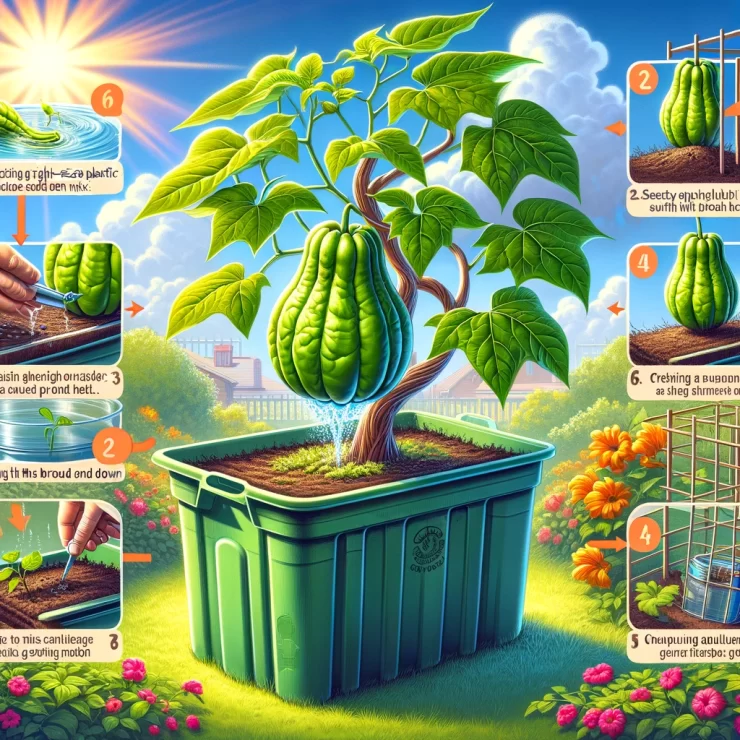Chayote, scientifically known as Sechium edule, is a versatile and nutritious vegetable that is gaining popularity in home gardening and small-scale farming. Its mild flavor and adaptability to various culinary uses make it a favorite among gardeners. For those with limited garden space or challenging soil conditions, growing chayote in plastic containers can be a practical and rewarding solution. In this article, we’ll explore some essential tips for maximizing chayote growth in plastic containers.
The Appeal of Container Gardening
Container gardening offers numerous advantages, making it an attractive choice for cultivating chayote:
Space Efficiency: Chayote vines can be vigorous and require ample space to spread. Growing them in containers allows you to save space while enjoying fresh chayote fruit.
Soil Control: Containers provide better control over soil quality and drainage, ensuring that chayote plants receive the ideal growing conditions.
Mobility: Containers can be moved to optimize sunlight exposure or protect plants from adverse weather conditions.
Pest Management: Container gardening can help reduce the risk of pests and diseases affecting your chayote plants.
Now, let’s delve into the specific tips for successfully growing chayote in plastic containers:
- Container Selection
Choose large and sturdy plastic containers with a minimum volume of 10 gallons (38 liters) or more. Chayote plants develop extensive root systems, and a spacious container will provide them with the necessary room to grow. Ensure that the container has drainage holes at the bottom to prevent waterlogging. - Soil Mix
Use a well-draining potting mix rich in organic matter. A blend of garden soil, compost, and perlite or vermiculite can create an ideal growing medium for chayote. Ensure good aeration and moisture retention in the soil. - Planting
Plant chayote seeds or the whole fruit in the container about 1 to 2 inches deep. Ensure that the sprout or growing tip faces upward. If using seeds, soak them in water for a day before planting to improve germination rates. Plant one chayote per container. - Sunlight
Chayote plants thrive in full sun, so choose a location for your containers where they receive at least 6-8 hours of direct sunlight daily. If necessary, move the containers to track the sun’s path throughout the day. - Support Structures
Chayote vines are climbing plants, and they require support structures to grow effectively. Install trellises or stakes in the containers to help the vines climb and produce more chayote fruit. - Watering
Maintain consistent moisture levels in the soil. Chayote plants prefer slightly moist soil, so water them regularly, especially during dry periods. Be cautious not to overwater, as this can lead to root rot. - Fertilization
Chayote plants benefit from regular feeding. Use a balanced, slow-release fertilizer to provide essential nutrients. Follow the recommended application rates on the fertilizer packaging. - Pruning
Regularly prune the chayote vines to encourage branching and better fruit production. Trim away excessive growth and dead or diseased leaves to promote a healthier plant. - Pollination
Chayote plants produce both male and female flowers. To ensure successful fruit formation, hand pollination may be necessary. Use a small brush or your fingers to transfer pollen from the male flowers to the female flowers when they are in bloom. - Harvesting
Chayote fruits are ready for harvest when they reach a size of 4 to 6 inches. Harvesting regularly encourages the plant to produce more fruit. Use a knife or pruners to cut the fruit from the vine carefully.
By following these tips, you can enjoy a bountiful chayote harvest from your plastic container garden. Whether you’re a seasoned gardener or a beginner, growing chayote in containers is a satisfying and practical way to enjoy this versatile vegetable while making the most of limited gardening space. With proper care and attention, your chayote plants will flourish and provide you with a delicious addition to your culinary adventures. Happy gardening!






Add comment